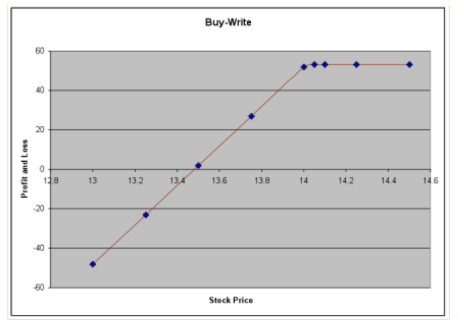Cypress Semiconductor (CY) is on the top of my radar for a new bullish position after a couple of days of call buying and put selling. Here are the put sales:
Tuesday: Seller of 3,000 June 12 Puts for $1.45 – Stock at 11.60 (trader willing to buy 300,000 shares at 12)
Wednesday: Seller of 2,000 June 11 Puts for $0.85 – Stock at 11.90 (trader willing to buy 200,000 shares at 11)
Based on this recent bullish order flow, I am considering adding a bullish position in CY via a put sale/buy-write.
As I’ve written in the past, put sales and buy-writes/covered calls have the exact same risk and reward. And when I’ve recommended buy-write trades, I’ve noted that selling puts is an alternative because they are the same trade. Here is a piece that I wrote in 2014 about the subject.
A Buy-Write is “Synthetically” Identical to Selling a Naked Put
Buy-writes, also known as covered calls, are one of the general public’s most popular options trading strategies. Selling naked puts (the sale of a put in an stock or index without a stock position), on the other hand, is feared by the general public because it’s considered to have much greater risk than a traditional buy-write. But when you break down the profit and loss potential of the two strategies, you can see that they’re identical.
Let’s start by looking at a buy-write/covered call:
A covered call is a strategy in which the trader holds a long position in a stock and writes (sells) a call option on the same stock in an attempt to generate income. Because the trader sold a call against his stock position, his upside is now limited.
For example, let’s say you own 100 shares of Alcoa (AA), which is currently trading at 13.99. You then theoretically sell one AA July 14 Call (expiring 7/19/2014) for $0.51 for each of your 100 shares.
Let’s take a look at a few buy-write/covered-call scenarios for the trade:
AA shares trade flat for the next month and the stock stays below the 14-strike price. The options you sold will expire worthless and you will have collected your full premium of $0.51 per share ($51). Thus you will have created a yield of 3.78% in one month’s time.
AA shares fall to 13.48. The options you sold will expire worthless and you will have collected your full premium of $0.51 per share ($51). However, your 100 shares of AA will have lost $51 of value. Thus, you are breakeven on the trade. At this time, you could simply sell the next month’s calls against your stock position.
AA shares fall to 13. Once again, the options you sold will expire worthless and you will have collected your full premium of $0.51 per share (or $51). However, your shares of AA will have lost $99 of value, leaving you down $48 on the trade. At this time, you could simply sell the next month’s calls against your stock or exit the entire position by selling your stock.
AA shares rise above 14. At this point, the owner of the 14 calls will exercise his right to buy the stock from you. This will leave you with no position. However, you have collected your $0.51 (or $51) and made $0.01 on the stock position.
Here is the profit and loss graph of this trade:
Now let’s take a look at the scenarios of selling a naked put in the same stock. (Remember, selling naked puts is the sale of a put in a stock or index without a stock position.) With the stock AA trading at 13.99, we could sell the July 14 Puts (expiring 7/19/2014) for $0.51.
Let’s take a look at a few naked-put sale scenarios for this trade:
AA shares trade flat for the next month and the stock stays below the 14-strike price. At this point, the options you sold will expire in the money, and you will have collected your premium of $0.51 per share ($51). Now you will be long the stock, but will have created a yield of 3.78% in one month’s time. At this time, you could simply sell the next month’s calls against your stock position.
AA shares fall to 13.48. At this point, the puts you sold will expire in the money and you will buy the stock at 14. However, since you collected your full premium of $0.51 per share ($51) this makes up for the loss on the stock. Thus, you are breakeven on the trade. At this time, you could simply sell the next month’s calls (switching to a buy-write now that you own shares) against your stock position.
AA shares fall to 13. At this point, your puts are in the money so you will be forced to buy the stock at 14. You will have collected your full premium of $0.51 per share (or $51). However, your shares of AA will have lost $99 of value, making you down $48 on the trade. At this time, you could simply sell the next month’s calls against your stock or exit the entire position by selling your stock.
AA shares rise above 14. At this point, the puts you sold will expire worthless and you will have collected your full premium of $0.51 per share, a yield of 3.78%.
Here is the profit and loss graph of this trade:
So what jumps out about these two charts? They are absolutely identical! The most you can make is the same, and the most you can lose is the same.
We can go through this exercise hundreds of times but each time the profit and loss graphs will be identical. Thus, executing a buy-write is “synthetically” identical to selling a naked put.


